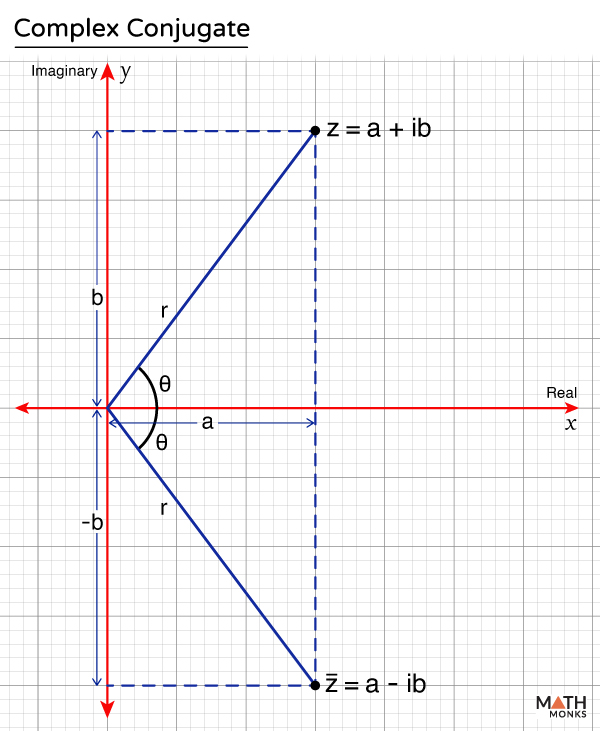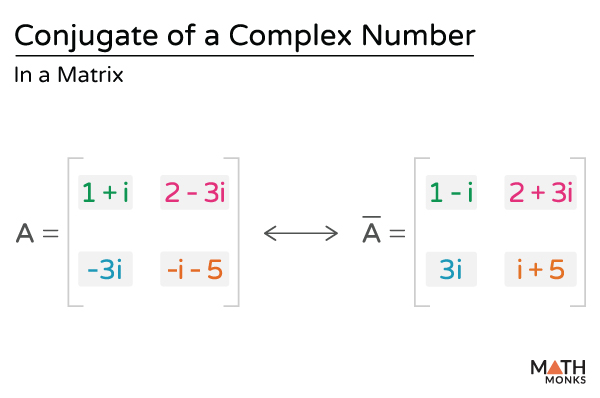The conjugate of a complex number a+ib, where a and b are real numbers, is written as a−ib. It involves changing the sign of the imaginary part, resulting in a new complex number with the same real part but an imaginary part with the opposite sign.
Mathematically, for the complex number z = a + ib, its complex conjugate is ${\overline{z}}$ = a – ib, and the complex conjugate of ${\overline{z}}$ is z.
Thus, z and ${\overline{z}}$ are a complex-conjugate pair.
For example,
The complex conjugate of:
3 – i is ${\overline{3-i}}$ = 3 + i,
-4 + 6i is ${\overline{-4+6i}}$ = -4 – 6i, and
7i is ${\overline{7i}}$ = -7i.
Graphing Complex Conjugates
The complex conjugate gives the mirror image of the complex number z = a + ib in the argand plane, as shown.
Here, z lies in the first quadrant, whereas its image ${\overline{z}}$ = a – ib is in the fourth quadrant with respect to the horizontal axis (x-axis).
When the complex number is represented in the polar form of z = reiθ, its conjugate is re-iθ.
Properties
- The conjugate of any purely real complex number is the number itself; z = ${\overline{z}}$.
- The conjugate of any purely imaginary number is the negative value of that number. If z = ${-\overline{z}}$ then, z + ${\overline{z}}$ = 0.
- The conjugate of the product of any two complex numbers equals the product of their conjugates, that is, ${\overline{zw}=\overline{z}\cdot \overline{w}}$.
- The conjugate of the quotient of any two complex numbers equals the quotient of their conjugates, that is, ${\overline{\left( \dfrac{z}{w}\right) }}$ = ${\dfrac{\overline{z}}{\overline{w}}}$, where w ≠ 0.
- On adding two complex numbers z and w, the conjugate of their sum equals the quotient of their conjugates, that is, ${\overline{z+w}}$ = ${\overline{z}+\overline{w}}$
- If a number w is subtracted from another number z, then the conjugate of their sum equals the quotient of their conjugates, that is, ${\overline{z-w}}$ = ${\overline{z}-\overline{w}}$.
- The difference between a complex number and its conjugate gives twice the imaginary part of the complex number, that is, z – ${\overline{z}}$ = ${2\cdot Im\left( z\right)}$.
- The product of a pair of complex conjugates z and ${\overline{z}}$ equals the square of the absolute value of the complex number, that is, ${z\cdot \overline{z}}$ = {Re(z)}2 + {Im(z)}2 = |z|2.
Multiplication
When we multiply a complex number by its conjugate, the result is always a real number.
For the complex number z = a + ib, its conjugate is ${\overline{z}}$ = a – ib
Now, on multiplying the complex number z by its conjugate ${\overline{z}}$, we get
(a + ib)(a – ib) = a(a – ib) + ib(a – ib) = a2 – i2b2
Substituting the value i2 = -1, the product is (a + ib)(a – ib) = a2 + b2
Thus, the product is a real number that equals the square of the complex number’s absolute value.
Let us consider another example. If 2 + 3i is a complex number, on multiplying by its conjugate number 2 – 3i, we get
(2 + 3i)(2 – 3i) = 22 – (3i)2 = 22 – 9i2 = 4 + 9 = 13 = |2 + 3i|2, which is again a real number.
Addition
Similarly, the sum is always a real number while adding a complex number by its conjugate.
Let us consider z = -3 + 5i, and its conjugate ${\overline{z}=-3-5i}$.
Adding these two numbers, we get ${z+\overline{z}}$ = (-3 + 5i) + (-3 – 5i)
= -3 + 5i – 3 – 5i = (-3 – 3) + (5i – 5i) = -6 = 2(-3), which is twice the real part of z.
Thus, we conclude that the sum of a complex number and its conjugate gives twice the real part of the complex number.
Conjugate Roots in Polynomial
If f(x) is a polynomial in which coefficients are real and a + ib is one of its roots, then its complex conjugate a – ib is also a root of f(x).
Let us understand this theorem with an example of polynomial f(x) = x3 – 11x2 + 40x – 50.
Here, the roots of the above polynomial are 5, -3 + i, -3 – i. Since -3 + i and -3 – i are the complex conjugates of each other, we conclude that the complex roots of any polynomial come in a pair.
Conjugate of Matrix
We can determine the complex conjugate of any matrix by calculating the complex conjugate of each individual matrix entry.
For example, a matrix A = ${\begin{bmatrix} a+ib & pi \\ c-id & -x+iy \end{bmatrix}}$.
Thus, the complex conjugate of the matrix A is ${\overline{A}}$ = ${\begin{bmatrix} a-ib & -pi \\ c+id & -x-iy \end{bmatrix}}$
Now, let us consider another example of a matrix and determine its complex conjugate.
Solved Examples
![]() Find the conjugate of the given complex numbers:
Find the conjugate of the given complex numbers:
a) 1 – 3i
b) 5 + 2i
c) ${\dfrac{1}{i-1}}$
Solution:
![]()
a) The conjugate of the complex number 1 – 3i is ${\overline{1-3i}}$ = 1 + 3i
b) The conjugate of the complex number 5 + 2i is ${\overline{5+2i}}$ = 5 – 2i
c) As we know, for two complex numbers z1, z2:
${\overline{\left( \dfrac{z_{1}}{z_{2}}\right) }}$ = ${\dfrac{\overline{z}_{1}}{\overline{z}_{2}}}$,
where z2 ≠ 0
The conjugate of a complex number ${\dfrac{1}{i-1}}$ is ${\overline{\left( \dfrac{1}{i-1}\right) }}$
= ${\dfrac{\overline{1}}{\overline{i-1}}}$
= ${\dfrac{1}{-i-1}}$
![]() If z = ${\dfrac{2}{-3i+1}}$, find the conjugate of z in the standard form (a + ib).
If z = ${\dfrac{2}{-3i+1}}$, find the conjugate of z in the standard form (a + ib).
Solution:
![]()
z = ${\dfrac{2}{-3i+1}}$
Let us rationalize the given complex number by multiplying the numerator and the denominator with (3i + 1).
⇒ z = ${\dfrac{2}{\left( -3i+1\right) }\times \dfrac{\left( 3i+1\right) }{\left( 3i+1\right) }}$
= ${\dfrac{2\left( 3i+1\right) }{\left( 1\right) ^{2}-\left( 3i\right) ^{2}}}$
= ${\dfrac{2\left( 3i+1\right) }{1+9}}$
= ${\dfrac{2\left( 3i+1\right) }{10}}$
= ${\dfrac{\left( 3i+1\right) }{5}}$
= ${\dfrac{1}{5}+\dfrac{3}{5}i}$
Thus, the conjugate of z (= ${\dfrac{2}{-3i+1}}$) in the standard form is
${\dfrac{1}{5}+\dfrac{3}{5}i}$.


